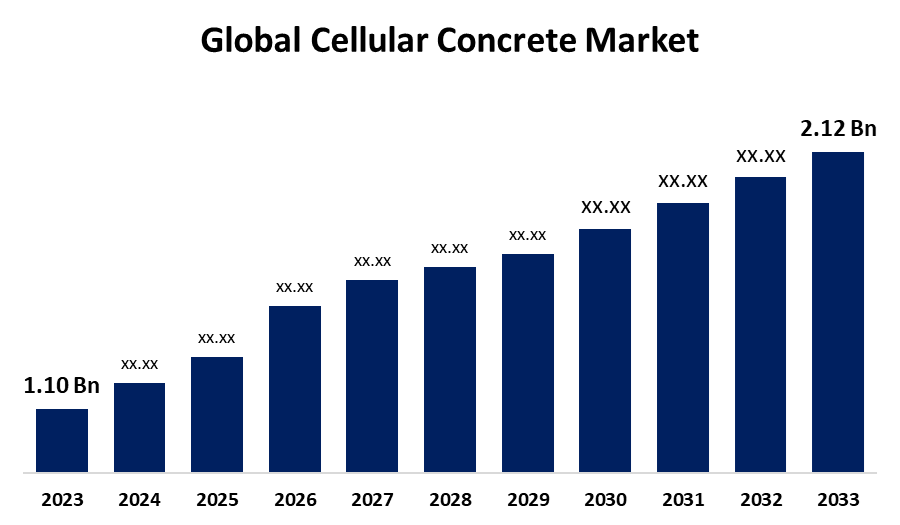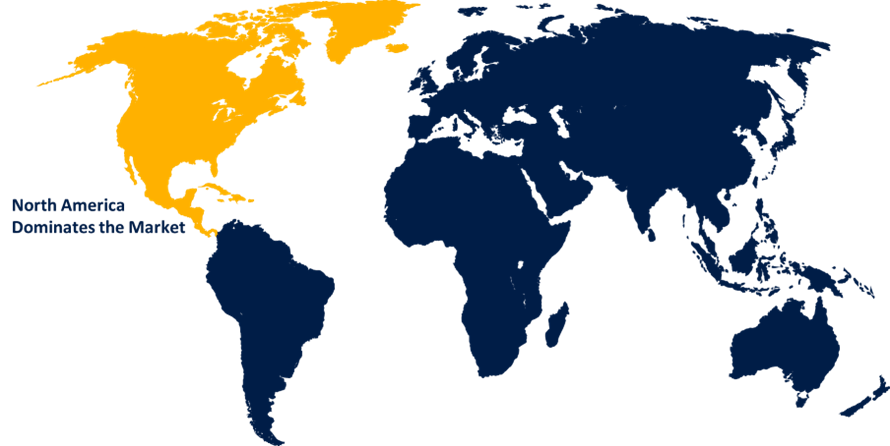Global Cellular Concrete Market Size to Worth $2.12 Billion By 2033 | CAGR Of 6.78%
Category: Chemicals & MaterialsGlobal Cellular Concrete Market Size to Worth $2.12 Billion By 2033
According to a research report published by Spherical Insights & Consulting, the Global Cellular Concrete Market Size to grow from USD 1.10 billion in 2023 to USD 2.12 billion by 2033, at a Compound Annual Growth Rate (CAGR) of 6.78% during the forecast period.

Get more details on this report -
Browse key industry insights spread across 220 pages with 100 Market data tables and figures & charts from the report on the global Cellular Concrete Market Size, Share, and COVID-19 Impact Analysis, By Application (Building Material, Road Sub-Bases, Concrete Pipes, Roof Insulation, and Bridge Abutment), By End-User (Residential And Non-Residential), and By Region (North America, Europe, Asia-Pacific, Latin America, Middle East, and Africa), Analysis and Forecast 2023 - 2033." Get Detailed Report Description Here: https://www.sphericalinsights.com/reports/cellular-concrete-market
The cellular concrete market is growing rapidly, driven by its lightweight, cost-effective, and eco-friendly characteristics. Also known as foam concrete, it is produced by incorporating foam into the mixture, resulting in a low-density material with excellent insulation properties. Cellular concrete is widely used in construction, roadworks, insulation, and infrastructure projects. Its popularity is fueled by advantages over traditional concrete, such as reduced weight, improved thermal performance, and ease of handling. Furthermore, its sustainability benefits, including lower carbon emissions and enhanced energy efficiency, contribute to its growing demand. The market is projected to expand as more industries adopt green building materials and urbanization continues to rise globally.
Cellular Concrete Market Value Chain Analysis
The value chain of the cellular concrete market consists of several stages, beginning with the procurement of raw materials such as cement, water, foam agents, and additives, which are sourced from suppliers and transported to manufacturing facilities. During production, these materials are mixed to create cellular concrete, with foam agents generating the necessary air pockets. The resulting concrete is then molded into blocks, panels, or other shapes to meet specific end-use requirements. Following production, the product is distributed through various channels to construction companies, contractors, and infrastructure developers. Key players in the value chain include raw material suppliers, manufacturers, distributors, and end-users. The market’s growth is driven by technological advancements, cost-effectiveness, and the rising demand for green building solutions, which add value at each stage of the chain.
Cellular Concrete Market Opportunity Analysis
The cellular concrete market offers substantial opportunities, fueled by the rising demand for sustainable and energy-efficient building materials. As green construction and eco-friendly solutions gain momentum, cellular concrete’s lightweight, thermal insulation, and fire-resistant properties position it as an appealing alternative to traditional materials. The growth of infrastructure development, especially in emerging economies, provides significant potential for cellular concrete in construction and road projects. Its use in cost-effective insulation and void-fill solutions further broadens its market reach. Innovations in production techniques and the growing adoption of energy-efficient building standards also support market expansion. Additionally, urbanization and the increasing preference for environmentally conscious construction practices continue to drive demand for cellular concrete, creating long-term opportunities across multiple sectors.
The expansion of the cellular concrete market is being strongly driven by the growth of the construction sector. As global urbanization accelerates, the demand for sustainable, cost-effective, and lightweight building materials rises, leading to greater adoption of cellular concrete in various construction applications. Its key benefits, such as superior thermal insulation, fire resistance, and ease of handling, make it an ideal material for modern building projects. Cellular concrete is increasingly utilized in residential, commercial, and infrastructure developments, including roadworks and building insulation. The industry’s shift toward green building practices and energy-efficient designs further supports the material's adoption. With the ongoing rise in large-scale infrastructure projects and eco-conscious construction initiatives, the cellular concrete market is expected to continue growing and expanding in the coming years.
The cellular concrete market encounters several challenges that could affect its growth. A primary concern is the high initial production cost, particularly when specialized foam agents and equipment are required, which may discourage smaller construction companies from using the material. Additionally, limited awareness and understanding of cellular concrete's benefits and applications in certain regions hinder its broader adoption. Quality control is another issue, as variations in foam generation and material properties can impact the consistency and performance of the final product. Despite its advantages, concerns about cellular concrete's long-term durability and resistance to factors like moisture remain. Furthermore, competition from traditional building materials, such as conventional concrete, and other lightweight alternatives may slow the market's expansion.
Insights by Application
The building material segment accounted for the largest market share over the forecast period 2023 to 2033. The building materials segment of the cellular concrete market is experiencing notable growth, fueled by the rising demand for sustainable and energy-efficient construction solutions. Cellular concrete's lightweight composition, coupled with its exceptional thermal insulation, fire resistance, and ease of handling, makes it a preferred material for a variety of building applications. It is widely used in constructing walls, floors, roofs, and partitions, providing a cost-effective alternative to traditional concrete. The growing focus on eco-friendly building practices and green certifications further boosts its adoption in residential, commercial, and industrial construction projects. Moreover, cellular concrete's role in improving energy efficiency and reducing the carbon footprint of buildings aligns with global sustainability objectives, driving its demand in the building materials segment. This trend is expected to continue as urbanization and construction activities grow.
Insights by End Use
The non-residential segment accounted for the largest market share over the forecast period 2023 to 2033. Cellular concrete’s lightweight structure and outstanding thermal insulation properties make it an ideal choice for constructing office buildings, warehouses, shopping malls, and schools. Its fire resistance and soundproofing capabilities also enhance safety and comfort in non-residential spaces. As urban areas grow and demand for sustainable construction increases, developers and contractors are turning to cellular concrete for its eco-friendly benefits and long-term cost savings. The rising focus on green building certifications and energy-efficient infrastructure is further driving the demand for cellular concrete in non-residential projects, solidifying its role as a crucial material for future commercial construction.
Insights by Region

Get more details on this report -
North America is anticipated to dominate the Cellular Concrete Market from 2023 to 2033. As the region embraces green building practices, cellular concrete’s lightweight, thermal insulation, and fire-resistant qualities make it an appealing choice for construction, infrastructure, and insulation applications. The market is further bolstered by urbanization and growth in both the residential and commercial construction sectors. Specifically, the U.S. and Canada are seeing increased adoption of cellular concrete in road construction, building insulation, and void filling projects. Although challenges such as higher production costs remain, the growing emphasis on energy-efficient buildings and sustainable materials is expected to propel the market’s growth in the coming years.
Asia Pacific is witnessing the fastest market growth between 2023 to 2033. The cellular concrete market in the Asia Pacific region is witnessing strong growth, fueled by rapid urbanization, infrastructure development, and an increasing emphasis on sustainable construction practices. The region’s thriving residential and commercial construction sectors, along with large-scale infrastructure projects, present significant opportunities for the adoption of cellular concrete. Additionally, government initiatives supporting green building standards and energy-efficient designs are further driving demand. However, challenges such as high production costs and inconsistent quality standards persist. Despite these obstacles, the growing focus on eco-friendly construction is expected to continue propelling the market’s expansion throughout the Asia Pacific region.
Recent Market Developments
- In April 2023, Sika has launched its new cellular concrete product, SikaGrout CC, specifically designed for grouting applications.
Major players in the market
- Saint Gobain (France)
- Xella Group (Germany)
- Cellucrete (U.S.)
- Cematrix (Canada)
- Litebuilt (Australia)
- Laston Italiana S.P.A (Italy)
- Cellular Concrete Technologies (U.S.)
- Aerix Industries (U.S.)
- ACICO (Kuwait)
- B. G. Shirke Construction Technology Pvt. Ltd (India)
- Broco Industries (Indonesia)
- Conco (U.S.)
- JK Lakshmi Cement Ltd (India)
- CellFill, LLC (U.S.)
- Aircrete Europe (Netherlands)
Market Segmentation
This study forecasts revenue at global, regional, and country levels from 2023 to 2033.
Cellular Concrete Market, Application Analysis
- Building Material
- Road Sub-Bases
- Concrete Pipes
- Roof Insulation
- Bridge Abutment
Cellular Concrete Market, End Use Analysis
- Residential
- Non-Residential
Cellular Concrete Market, Regional Analysis
- North America
- US
- Canada
- Mexico
- Europe
- Germany
- Uk
- France
- Italy
- Spain
- Russia
- Rest of Europe
- Asia Pacific
- China
- Japan
- India
- South Korea
- Australia
- Rest of Asia Pacific
- South America
- Brazil
- Argentina
- Rest of South America
- Middle East & Africa
- UAE
- Saudi Arabia
- Qatar
- South Africa
- Rest of the Middle East & Africa
About the Spherical Insights & Consulting
Spherical Insights & Consulting is a market research and consulting firm which provides actionable market research study, quantitative forecasting and trends analysis provides forward-looking insight especially designed for decision makers and aids ROI.
Which is catering to different industry such as financial sectors, industrial sectors, government organizations, universities, non-profits and corporations. The company's mission is to work with businesses to achieve business objectives and maintain strategic improvements.
CONTACT US:
For More Information on Your Target Market, Please Contact Us Below:
Phone: +1 303 800 4326 (the U.S.)
Phone: +91 90289 24100 (APAC)
Email: inquiry@sphericalinsights.com, sales@sphericalinsights.com
Contact Us: https://www.sphericalinsights.com/contact-us
Follow Us: LinkedIn | Facebook | Twitter
Need help to buy this report?